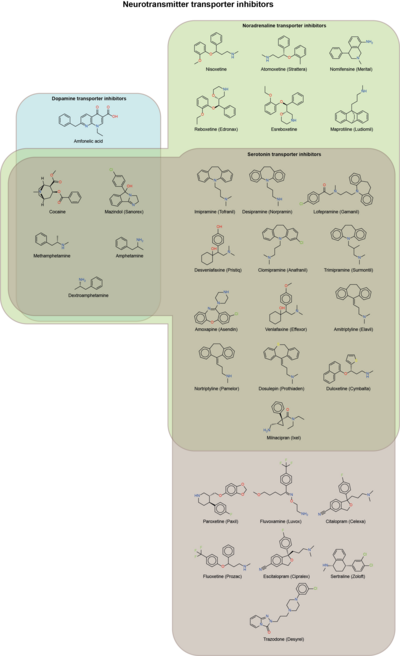| Revision as of 01:12, 2 December 2020 editMonkbot (talk | contribs)Bots3,695,952 editsm Task 18 (cosmetic): eval 5 templates: del empty params (3×);Tag: AWB← Previous edit |
Revision as of 14:25, 6 January 2021 edit undoMonkbot (talk | contribs)Bots3,695,952 editsm Task 18 (cosmetic): eval 5 templates: hyphenate params (1×);Tag: AWBNext edit → |
| Line 27: |
Line 27: |
|
NRIs are commonly used in the treatment of conditions like ] and ] due to their ] effects and in ] due to their ] effects. They are also frequently used as ]s for the treatment of ], ] and ]. Additionally, many ] such as ] and ] possess NRI activity, though it is important to mention that NRIs without combined ] (DRI) properties are not significantly rewarding and hence are considered to have a negligible ].<ref name="pmid15283948">{{cite journal |vauthors=Wee S, Woolverton WL | title = Evaluation of the reinforcing effects of atomoxetine in monkeys: comparison to methylphenidate and desipramine | journal = Drug and Alcohol Dependence | volume = 75 | issue = 3 | pages = 271–6 |date=September 2004 | pmid = 15283948 | doi = 10.1016/j.drugalcdep.2004.03.010 }}</ref><ref name="pmid15526000">{{cite journal |vauthors=Gasior M, Bergman J, Kallman MJ, Paronis CA | title = Evaluation of the reinforcing effects of monoamine reuptake inhibitors under a concurrent schedule of food and i.v. drug delivery in rhesus monkeys | journal = Neuropsychopharmacology | volume = 30 | issue = 4 | pages = 758–64 |date=April 2005 | pmid = 15526000 | doi = 10.1038/sj.npp.1300593 | doi-access = free }}</ref> However, norepinephrine has been implicated as acting synergistically with dopamine when actions on the two neurotransmitters are combined (e.g., in the case of ]s) to produce rewarding effects in psychostimulant drugs of abuse.<ref name="pmid11071707">{{cite journal |vauthors=Rothman RB, Baumann MH, Dersch CM, etal | title = Amphetamine-type central nervous system stimulants release norepinephrine more potently than they release dopamine and serotonin | journal = Synapse | volume = 39 | issue = 1 | pages = 32–41 |date=January 2001 | pmid = 11071707 | doi = 10.1002/1098-2396(20010101)39:1<32::AID-SYN5>3.0.CO;2-3 }}</ref> |
|
NRIs are commonly used in the treatment of conditions like ] and ] due to their ] effects and in ] due to their ] effects. They are also frequently used as ]s for the treatment of ], ] and ]. Additionally, many ] such as ] and ] possess NRI activity, though it is important to mention that NRIs without combined ] (DRI) properties are not significantly rewarding and hence are considered to have a negligible ].<ref name="pmid15283948">{{cite journal |vauthors=Wee S, Woolverton WL | title = Evaluation of the reinforcing effects of atomoxetine in monkeys: comparison to methylphenidate and desipramine | journal = Drug and Alcohol Dependence | volume = 75 | issue = 3 | pages = 271–6 |date=September 2004 | pmid = 15283948 | doi = 10.1016/j.drugalcdep.2004.03.010 }}</ref><ref name="pmid15526000">{{cite journal |vauthors=Gasior M, Bergman J, Kallman MJ, Paronis CA | title = Evaluation of the reinforcing effects of monoamine reuptake inhibitors under a concurrent schedule of food and i.v. drug delivery in rhesus monkeys | journal = Neuropsychopharmacology | volume = 30 | issue = 4 | pages = 758–64 |date=April 2005 | pmid = 15526000 | doi = 10.1038/sj.npp.1300593 | doi-access = free }}</ref> However, norepinephrine has been implicated as acting synergistically with dopamine when actions on the two neurotransmitters are combined (e.g., in the case of ]s) to produce rewarding effects in psychostimulant drugs of abuse.<ref name="pmid11071707">{{cite journal |vauthors=Rothman RB, Baumann MH, Dersch CM, etal | title = Amphetamine-type central nervous system stimulants release norepinephrine more potently than they release dopamine and serotonin | journal = Synapse | volume = 39 | issue = 1 | pages = 32–41 |date=January 2001 | pmid = 11071707 | doi = 10.1002/1098-2396(20010101)39:1<32::AID-SYN5>3.0.CO;2-3 }}</ref> |
|
|
|
|
|
A meta analysis published in BMJ in 2011 concluded that the selective NRI ] is indistinguishable from placebo in the treatment of depression.<ref>{{cite journal |vauthors=Eyding D, Lelgemann M, Grouven U, etal |title=Reboxetine for acute treatment of major depression: systematic review and meta-analysis of published and unpublished placebo and selective serotonin reuptake inhibitor controlled trials |journal=BMJ |volume=341 |pages=c4737 |year=2010 |pmid=20940209 |pmc=2954275 |doi= 10.1136/bmj.c4737}}</ref> A second review by the European Medicines Agency concluded that reboxetine was significantly more effective than placebo, and that its risk/benefit ratio was positive. The latter review, also examined the efficacy of reboxetine as a function of baseline depression, and concluded that it was effective in severe depression and panic disorder but did not show effects significantly superior to placebo in mild depression.<ref>{{cite web |url=http://www.mhra.gov.uk/home/groups/pl-p/documents/websiteresources/con129107.pdf |title=MHRA Public Assessment Report |accessdate=2014-04-26 |archive-url=https://web.archive.org/web/20140427001026/http://www.mhra.gov.uk/home/groups/pl-p/documents/websiteresources/con129107.pdf |archive-date=2014-04-27 |url-status=dead }}</ref> |
|
A meta analysis published in BMJ in 2011 concluded that the selective NRI ] is indistinguishable from placebo in the treatment of depression.<ref>{{cite journal |vauthors=Eyding D, Lelgemann M, Grouven U, etal |title=Reboxetine for acute treatment of major depression: systematic review and meta-analysis of published and unpublished placebo and selective serotonin reuptake inhibitor controlled trials |journal=BMJ |volume=341 |pages=c4737 |year=2010 |pmid=20940209 |pmc=2954275 |doi= 10.1136/bmj.c4737}}</ref> A second review by the European Medicines Agency concluded that reboxetine was significantly more effective than placebo, and that its risk/benefit ratio was positive. The latter review, also examined the efficacy of reboxetine as a function of baseline depression, and concluded that it was effective in severe depression and panic disorder but did not show effects significantly superior to placebo in mild depression.<ref>{{cite web |url=http://www.mhra.gov.uk/home/groups/pl-p/documents/websiteresources/con129107.pdf |title=MHRA Public Assessment Report |access-date=2014-04-26 |archive-url=https://web.archive.org/web/20140427001026/http://www.mhra.gov.uk/home/groups/pl-p/documents/websiteresources/con129107.pdf |archive-date=2014-04-27 |url-status=dead }}</ref> |
|
|
|
|
|
A closely related type of drug is a ] (NRA). |
|
A closely related type of drug is a ] (NRA). |


